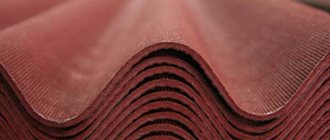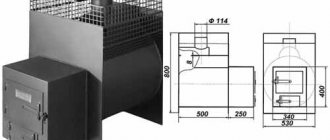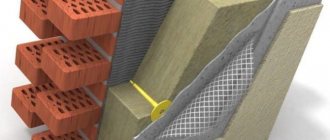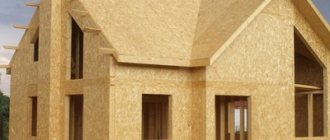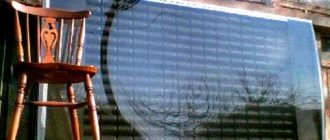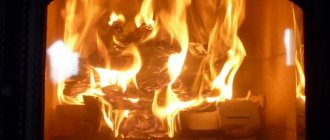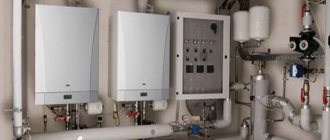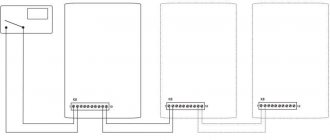The appearance on the domestic market and active popularization of such an energy carrier as fuel briquettes poses some difficulties for users of boiler equipment that runs on coal and wood. In order to make a choice, you should understand in detail what briquettes for heating (or Euro-firewood) are.
Fuel briquettes are used as fuel for solid fuel boilers, stoves and fireplaces
What are fuel briquettes?
Fuel briquettes are a relatively new type of solid fuel. They are made by pressing fine-grained raw materials of natural origin. Sawdust, wheat, rice or buckwheat husks, and sunflower husks can be used as such raw materials. In addition, fuel briquettes are pressed from leaves, straw, reeds, tree bark, and pine needles. Pellets are also made from reeds.
During the pressing process, strong pressure is applied to the raw materials from which wood briquettes are made, resulting in the release of a special substance - lignin. It acts as a connecting component. Thus, no additional chemicals are used in the production of wood pellets, which makes such fuel environmentally friendly.
Various types of raw materials can be used for the production of fuel briquettes
The release of lignin is only possible in cases where significant pressure is applied to the raw materials from which wood briquettes are made. It is quite difficult to fulfill this condition when making fuel briquettes with your own hands using homemade equipment, so in such cases binders are added to the raw material mixture. Clay, wallpaper glue, soaked paper or cardboard can be used as the latter.
Pressed briquettes for combustion can differ not only in the material of manufacture and the degree of density of the internal structure, but also in their geometric parameters, in particular shape and size.
Scheme of the technological process for producing briquettes
Some features of the technology
By briquetting, coal dust, fines, screenings and substandard materials can be converted into marketable products.
The raw materials for this are brown and black coals, which come after washing and sifting on sieves. With low density and low heat of combustion, they have an important advantage - low cost. Anthracite is an expensive but highly efficient product that has the best heat transfer properties, while brown coal is the most common and economical option. Pressed charcoal will require complex technologies and additional equipment. Read also: main types of coal and their purpose.
The shape and density of briquettes affect energy efficiency indicators: they ignite easily, burn evenly, maintain a constant temperature in the firebox and do not fall apart until the end of the process. The exothermic reaction time ranges from 6 to 12 hours, and after that only 3% of ash remains, while traditional coal forms about 30%. Packaged solid fuel can be stored in the open air; it does not freeze in the cold and does not collapse until the very end of combustion. In packaged form, the products are supplied to retail trade or exported.
In this video you will learn how briquettes are made from coal dust:
The properties of briquetted coal depend on the source raw material, its environmental cleanliness and security, and the form of packaging.
But the main difference exists between the two main varieties intended for use:
- in industry (the composition contains binder additives: coal pitch, petroleum bitumen, resin, molasses and lime, ammonium lignosulfonate or polymers);
- in everyday life (without binder additives).
Manufacturers of solid fuel for the needs of metallurgy and petrochemistry introduce additives of liquid glass, cement, and bitumen mixtures into coal raw materials, which makes such solid fuel unacceptable for use in residential premises. Therefore, briquettes of the first type are strictly prohibited when lighting fires for cooking in home grills, barbecues and other ovens. The high temperatures created by briquettes will damage household equipment. Food products that come into contact with smoke from the thermal decomposition of binders will become unfit for consumption. When burning, toxic substances are released, which in industrial conditions are captured, purified and released into the atmosphere by special devices. Manufacturers of briquettes for household use used molasses and starch as binders, but today these technologies have lost their practical significance.
Main varieties
There are three main types of Euro firewood offered on the modern market, which, while not having any fundamental differences in composition, differ from each other in the density of the internal structure and geometric shape:
- fuel briquettes RUF (RUF);
- European firewood Pini Kay (Pini Kay);
- fuel briquettes Nestro (Nestro).
Fuel briquettes Ruf
RUF wood briquettes, for the production of which sawdust, small chips or shavings are used, have the shape of a rectangle. They are distinguished by the lowest price when compared with other types of pellets. When using such fuel briquettes, it should be borne in mind that the heating boiler must be equipped with a forced ventilation system.
Fuel briquettes "Pini Kay"
Pini Kay fuel briquettes are fired at the final stage of production, which makes them more resistant to high humidity. Pellets of this type differ from RUF fuel briquettes in their geometric shape: in cross section they can have the shape of a cylinder or hexagon with a hole in the central part. Thanks to this hole, they can be successfully used even in ovens that are not equipped with a forced ventilation system. The cost of pellets of this type, which can be easily distinguished from RUF fuel briquettes even from a photo, is higher, which is explained by the more complex technology of their production.
Round fuel briquettes Nestro
Home packaging of solid fuel
The process of artisanal briquetting differs from what occurs in a factory in its low level of mechanization and in the fact that instead of drying the original components, they are wetted. For the heating needs of a standard private house, you do not have to organize a grand production with serious energy costs and expensive equipment. It is possible to prepare three or four tons of economical solid fuel for the autumn-winter period using old-fashioned methods.
Stages of home briquette production:
- Coal dust is taken in pure form or with clay additives in a ratio of 10:1 and diluted with water until the required density is obtained. A safe clay binder prevents the destruction of finished briquettes, but increases the ash content. High quality mixing allows you to use a construction mixer.
- The prepared forms are filled with a homogeneous solution. Both special containers and pots, buckets or used containers are suitable for this. Briquettes can simply be sculpted by hand, as they did before.
- Finished products are dried and stored in storage areas.
Homemade coal briquettes differ from factory ones in disadvantageous qualities. They have an imperfect shape, different levels of humidity and heat transfer, and low strength, which makes transporting products difficult. But this does not prevent homemade coal briquettes from being economical and easy to use, having low cost and high calorific value. These advantages distinguish them favorably from caked dust.
Home production can be automated if desired and if funds are available. To do this, you need to purchase or make your own manual briquetting machine.
When creating equipment similar to industrial equipment, a press for producing homemade bricks is taken as a basis. It will be improved with a loading hopper and a device for forming briquettes in the form of bars, pillows or cylinders. If you provide for the formation of through holes, this will promote better combustion and increase the heat transfer of finished products.
You can do pressing at home
The technology for handicraft pressing of briquettes looks like this:
- Coal dust and substandard materials are thoroughly crushed, and the final strength indicators depend on this.
- The raw materials are mixed with water and clay until a viscous and sticky consistency is obtained.
- The mass is loaded into the hopper and, by pressing a lever, it is squeezed out, filling the mold.
- When the lever moves back, the finished briquette is pushed out, removed and laid out in the sun to dry.
The production of a machine for home briquetting of charcoal using the extrusion method should be entrusted to a professional turner. You will have to pay a considerable amount for materials and labor for manufacturing the housing, matrix and screw, but the productivity of such equipment will also be higher.
Fuel briquettes or regular firewood: what to choose?
What to give preference to: regular firewood or fuel briquettes? To answer this question, we need to study the advantages and disadvantages of both.
Let us list the most important advantages of fuel briquettes:
- A fuel briquette, when compared with conventional firewood, burns 4 times longer than the latter, which contributes to the economical consumption of such fuel.
- After combustion of pellets, very little ash remains - about 1% of the total mass of fuel used. When using conventional firewood, this figure can reach up to 20% of the total mass of fuel used. The ash remaining after the combustion of wood or any other type of briquettes can be used as a fertilizer containing a large amount of potassium.
- The amount of thermal energy released when burning Eurowood is almost twice as much as when using conventional firewood.
- During combustion, fuel briquettes emit heat almost all the time, which cannot be said about ordinary firewood, the heat transfer of which decreases rapidly as it burns.
- When burned, fuel briquettes practically do not spark and emit a minimal amount of smoke and odor. Thus, this type of fuel does not create discomfort and does not harm the environment. In addition, when burning firewood contaminated with mold or mildew, toxic smoke is generated, which is excluded when using Euro firewood, for the production of which carefully dried sawdust or shavings are used.
- When using wood briquettes as fuel, significantly less soot is deposited on the walls of chimneys than when using conventional firewood.
- The compact dimensions that distinguish Eurowood allow for more economical use of the space for storing such fuel. Moreover, when storing fuel briquettes, which are usually placed in neat packaging, no debris and wood dust are generated, which are necessarily present in places where ordinary firewood is stored.
Compact storage is the indisputable advantage of fuel briquettes
Naturally, this type of fuel also has certain disadvantages:
- Due to the high density of the internal structure, fuel briquettes take a long time to flare up; it will not be possible to quickly warm up a room using such fuel.
- The low moisture resistance of Euro firewood can cause it to simply deteriorate if the required storage conditions are not provided.
- Fuel briquettes, which are compressed sawdust, are characterized by fairly low resistance to mechanical damage.
- When burning fuel briquettes, there is no such beautiful flame as when using conventional firewood, which somewhat limits the use of pellets as fuel for fireplaces, where the aesthetic component of the combustion process is also very important.
Comparison of the main parameters of various types of solid fuel
To decide between fuel briquettes and regular firewood, you should take into account the advantages of the latter.
- When burning ordinary firewood, as mentioned above, more heat is generated; accordingly, with the help of such fuel you can quickly warm up a heated room.
- The cost of ordinary firewood in comparison with fuel briquettes is much lower.
- Firewood is more resistant to mechanical damage.
- When burning wood, a beautiful flame is formed, which is a particularly important quality for fireplace fuel. In addition, when wood burns, essential oils contained in wood are released into the surrounding air, which has a beneficial effect on the nervous and respiratory systems of a person in a heated room.
- The characteristic crackling sound that firewood makes when burning also has a beneficial effect on the nervous system.
- The ash remaining after burning conventional firewood does not have such a tart smell as the product of pellet combustion.
Advantages and disadvantages
Heating with alternative fuels has its positive and negative sides.
Pros:
- High calorific value and heat transfer. These indicators are significantly higher for alternative fuels than for conventional logs.
- Long burning time. Therefore, their consumption is significantly less than that of firewood or coal.
- Uniform combustion. Briquettes burn without unnecessary noise and smoke. And they produce less ash than coal or firewood. This makes it easier to clean the oven device after use.
- Slight release of tarry substances. Thanks to this, the chimney does not become clogged.
- Long shelf life. Briquettes can be stored from 1 to 5 years (depending on manufacture).
- Environmentally friendly. The product is natural, without various impurities. Safe for people and the environment.
Minuses:
- Briquette fuel prices are higher. Firewood is much cheaper. But thanks to economical consumption, the costs are worth it.
- Purchasing such goods in some cities or towns is difficult.
- Products should be stored in accordance with the instructions. Therefore, you should prepare a clean and dry place.
- The ash gives off a pungent odor.
Economic component
When deciding between regular firewood and fuel briquettes, you should also take into account the cost of both types of solid fuel. Euro firewood, which is produced today by many domestic manufacturers, on average costs 2–3 times more than regular firewood. Meanwhile, inexpensive ordinary firewood is rarely of uniform quality.
Most often, the total mass of firewood contains only 20–30% of well-dried logs, while up to 50% of the total mass of purchased firewood can be logs with high humidity, and 20–30% may be stale firewood of not very high quality. If we talk about fuel briquettes, then the moisture content of such fuel, for the production of which well-dried sawdust is used, does not exceed 9%.
Briquettes clearly outperform firewood in terms of transportation
When making a choice between fuel briquettes and firewood, you can also take into account the following facts.
- The burning time of fuel briquettes, which is about two hours, is almost twice the period during which ordinary firewood burns.
- The heat transfer of firewood, which is especially noticeable when located in close proximity to a heating boiler, is significantly higher than that of fuel briquettes.
- The amount of ash remaining after burning fuel briquettes is approximately ¼ less than the amount of combustion products remaining after burning conventional firewood.
Thus, pellets are better used as fuel for long-burning boilers, and ordinary firewood is more suitable for lighting fireplaces. In any case, when making a choice in favor of one or another type of solid fuel, you should be guided by all of the above facts, and also take into account the type of heating equipment.
Kinds
The method of processing raw materials plays an important role. Taking into account the manufacturing process, briquettes can be divided:
- Piny-kay. Fuel having the highest density of 1.40 g/cm3. The shape is similar to a cube or hexagon, which has a hole in the middle. The air inside the cavity ensures even combustion.
- Low density products – 0.8 g/cm3. These are squares or rectangles made from the smallest particles of material. They are characterized by high thermal conductivity and long-lasting combustion. Convenient to store and transport, do not take up much space.
- Products made from large sawdust with medium density. Their disadvantages include rapid combustion, frequent loss of shape and deformation. Due to low production costs, they have a relatively low price.
How to make using pellets more profitable
You can make the use of pellet fuel economically profitable if you make briquettes yourself. By creating equipment that can be operated either manually or through a hydraulic mechanism, you can independently produce fuel briquettes for your needs from straw, wood waste, as well as fuel briquettes from sunflower husks and other waste remaining after processing agricultural raw materials. Naturally, you can organize your own production of fuel briquettes only if you have access to a sufficient amount of cheap raw materials.
Homemade manual briquette press with two dies
Homemade equipment for making fuel briquettes, as mentioned above, can be operated manually, using a lever or screw mechanism, or operated through a hydraulic mechanism, which can be used as a car jack. Regardless of the type of drive, the main design elements of a device intended for the production of pellets are:
- a matrix in the working cavity of which the formation of a fuel briquette occurs;
- a punch, which, by exerting pressure on bulk raw materials, compresses it;
- a mixing drum, where the components from which the fuel briquette will be formed are mixed;
- loading and unloading trays;
- a powerful frame on which all structural elements of the device are fixed.
When making pellets using homemade equipment, you should keep in mind that a binder must be added to the mixture from which fuel briquettes will be formed. As such a substance, ordinary clay, wallpaper glue, soaked paper and cardboard can be used.
How much are?
The price of briquettes for heating a furnace depends on the technology and material from which the product is made.
- Alternative fuel of the Pini-kay type made from pine needles will cost an average of 8,900 rubles. for one ton, from birch - from 9,500 rubles.
- RUF briquettes are cheaper: sawdust 6500, pine needles 6000, pine and birch 6500, birch 6900 rubles.
- Nestro briquettes are the most inexpensive: 7500 per ton. Peat briquettes will cost the stove owner 8,000 rubles, and coal briquettes – 9,500 rubles.
You can purchase briquettes in specialized stores, as well as on websites on the Internet. Online shopping will be a little more profitable, since you will not have to pay for the services of consultants and renting store premises. But in the store you can personally see the quality of such a purchase, which is very difficult to do via the Internet.
Mold making
But first you need to make a simple mold
(Fig. 1)
. Its design is a welded rectangular box with a removable bottom and lid. Individual mold details and their dimensions are shown in
rice. 2
. Of course, the dimensions of the mold can be changed either up or down - it all depends on the size of the existing heating system.
devices
and him
firebox
Rice. 1 .
Design of a mold for making paper briquettes Holes drilled in the lid and bottom serve for drainage
water
when pressing. Vertical cuts in the side walls of the box are also intended for the same purpose. If the holes in them are made round, this may make it difficult to remove the finished briquettes from the mold. And so that the cuts do not reduce the strength of the side walls, the area around them is reinforced with 10 x 10 mm corners welded on the outside.
Rice. 2 . Mold parts: 1 - side wall (2 pcs.); 2 — end wall (2 pcs.); 3 — removable cover; 4 - removable bottom
Along the lower edges of the side walls, 25 x 25 mm corners are welded on the inside - supports for installing the bottom. After preparing all the parts, the side walls are welded into a rectangular box. Relatively thin-walled parts may “lead” when welded, so it is advisable to make the seams intermittent.
It is better to weld the corners only from the outside, without leaving any protrusions or irregularities on the internal surfaces of the box that could interfere with pressing and removal of the finished product.
The cheaper way to heat your home
The price of fuel for heating a private home is of great importance, but it is pointless to consider it in isolation from heat transfer. We will calculate the cost of heating taking into account both parameters.
Combustion of peat fuel 3 hours after laying
In the area where our expert lives, the following prices are asked for proven types of fuel:
- Freshly cut firewood – 20 USD. e. for 1 m³. Let's tie the price to the weight: 20 dollars for 600 kg or 33 cu. e. for 1 ton.
- Briquettes made from pressed sunflower husks – $57 per ton.
- Peat briquette – 84 USD. e./1 t.
It is easy to calculate that 10 kg of wood will cost 33 cents, the rest of the fuel - 57 and 84 cents, respectively. Then 1 hour of heating on wooden logs costs 33 / 1.5 = 22 cents (remember, the wood burned out in an hour and a half).
In a similar way, we determine the hourly rate for burning briquettes:
- pressed husk: 57 / 2.17 (2 hours 10 minutes) = 26 cents;
- briquetted peat: 84 / 3 = 28 cents.
Burning briquetted sunflower seed husks.
Interesting result, right? In our case, heating up an absolutely cold building costs 5.28 USD. e. per day for wood, 6.24 dollars for pressed husks and 6.72 cu. e. - on peat “bricks”.
An important nuance. The prices of solid fuel in your region are probably different, and the boiler room has different heating equipment. But the ratio and principle of calculation remain unchanged. Apply this technique and consider what is more profitable - firewood or briquettes in your particular case.
Please note that we took the cost of raw wood (and it will decay sooner) and divided it by the time of full combustion of dry wood. That is, the difference between traditional fuel and briquettes is minimized. We invite you to track the progress of the experiment on video and listen to an expert’s opinion on this matter.
Necessary equipment
Despite the relative ease of obtaining fuel, you still have to acquire some equipment. Or adapt existing ones to new needs. What you will need:
- Chopper. You can’t do without it, because the finer the raw material, the denser the finished briquette. And when making it with your own hands, materials of various fractions are used. You won’t have to spend money on purchases if your farm has a device that chops vegetation to send it to compost. Inventors with skillful hands adapt an old activator-type washing machine for a shredder - they change the activator itself with knives;
- Any container where the raw materials will be mixed before being placed in the matrix. It would be a good idea to supplement the “trough” with a miniature concrete mixer or construction mixer. In the absence of both, get ready for hard physical work of kneading raw materials;

